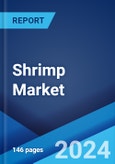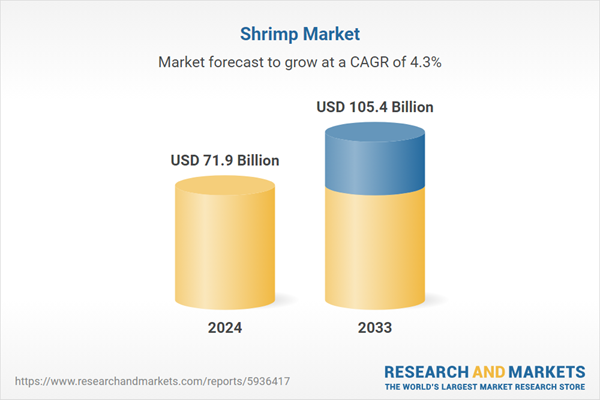The global shrimp market size reached USD 71.9 billion in 2024. Looking forward, the publisher expects the market to reach USD 105.4 billion by 2033, exhibiting a growth rate (CAGR) of 3.9% during 2025-2033. The market is experiencing moderate growth driven by the increasing consumer demand for seafood, the growing awareness of the health benefits associated with shrimp consumption, and a surge in aquaculture practices, resulting in higher shrimp production.
Shrimp in this segment, with less than 21 pieces per pound, are often referred to as ""jumbo shrimp."" These large-sized shrimp are prized for their succulent and meaty texture. They are typically used in gourmet dishes, grilling, or as impressive appetizers in fine dining establishments.
The market research report has provided a comprehensive analysis of the competitive landscape. Detailed profiles of all major companies have also been provided.
3. What has been the impact of COVID-19 on the global shrimp market?
4. What is the breakup of the global shrimp market based on the species?
5. What is the breakup of the global shrimp market based on the size?
6. What are the key producing regions in the global shrimp market?
7. What are the key consuming regions in the global shrimp market?
Shrimp Market Trends:
Rising consumer demand
Consumer demand for shrimp is on the rise globally. Shrimp is a popular seafood choice due to its mild flavor and versatility in various cuisines. As incomes increase and dietary preferences evolve, more people are including shrimp in their diets. This growing demand is particularly noticeable in emerging economies where rising disposable incomes have led to increased consumption of seafood, including shrimp. The expansion of urban populations and changing lifestyles, which favor convenient and protein-rich foods like shrimp, further fuel this demand. As a result, the shrimp market is benefiting from the increasing appetite for this delectable seafood.Growing aquaculture industry
Aquaculture has become a driving force behind the growth of the shrimp market. Shrimp farming, in particular, has seen significant expansion to meet the escalating demand. This growth is attributed to the development of advanced aquaculture techniques and technologies that enhance shrimp production efficiency. Controlled environments, improved breeding practices, and the adoption of sustainable farming methods have led to higher yields and reduced environmental impact. Shrimp farming is also attractive due to its shorter production cycle compared to wild-caught shrimp, enabling faster response to market demand fluctuations. Consequently, aquaculture's role as a major source of shrimp has propelled the industry's growth and facilitated a consistent supply of shrimp products to meet global consumption needs.Increasing health awareness among the masses
Shrimp's perceived health benefits and nutritional value are significant drivers of market growth. Shrimp is a low-calorie, high-protein seafood option that is rich in essential nutrients like omega-3 fatty acids, vitamins, and minerals. Consumers are increasingly health-conscious, seeking out nutritious and protein-packed foods. Shrimp aligns with these preferences, making it a popular choice for those looking to maintain a balanced diet. Additionally, shrimp is often considered a healthier alternative to red meat due to its lower saturated fat content. As health and wellness trends continue to influence food choices, the positive nutritional profile of shrimp positions it as a favored option in the global seafood market, contributing to its sustained growth and demand.Rising global population and income levels
Demographic factors play a crucial role in driving the shrimp market. The world's growing population, coupled with increasing disposable incomes, has translated into higher seafood consumption, including shrimp. As economies continue to grow, more consumers have the financial means to include seafood, a relatively premium protein source, in their diets. This trend is particularly evident in emerging markets, where urbanization and lifestyle changes have led to greater demand for convenient and value-added shrimp products. The combination of a larger consumer base and higher purchasing power has resulted in sustained market growth and opportunities for shrimp producers and suppliers to cater to a diverse and expanding customer base.Shrimp Market Segmentation
The publisher provides an analysis of the key trends in each segment of the market, along with forecasts at the global and regional levels for 2025-2033. Our report has categorized the market based on environment, species, shrimp size, and distribution channel.Breakup by Environment:
- Farmed Shrimp
- Wild Shrimp
Farmed shrimp accounts for the majority of the market share
The report has provided a detailed breakup and analysis of the market based on the environment. This includes farmed and wild shrimp. According to the report, farmed shrimp represented the largest segment.Breakup by Species:
- Penaeus Vannamei
- Penaeus Monodon
- Macrobrachium Rosenbergii
- Others
Penaeus Vannamei holds the largest share in the industry
A detailed breakup and analysis of the market based on the species have also been provided in the report. This includes Penaeus Vannamei, Penaeus monodon, macrobrachium rosenbergii, and others. According to the report, Penaeus Vannamei accounted for the largest market share.Breakup by Shrimp Size:
- < 21
- 21-25
- 26-30
- 31-40
- 41-50
- 51-60
- 61-70
- >70
Shrimp in this segment, with less than 21 pieces per pound, are often referred to as ""jumbo shrimp."" These large-sized shrimp are prized for their succulent and meaty texture. They are typically used in gourmet dishes, grilling, or as impressive appetizers in fine dining establishments.
Breakup by Distribution Channel:
- Hypermarkets and Supermarkets
- Convenience Stores
- Hotels and Restaurants
- Online Sales
- Others
Breakup by Region:
Major Producing Regions:
- China
- India
- Indonesia
- Vietnam
- Thailand
- Ecuador
- Others
China leads the market, accounting for the largest shrimp market share
The market research report has also provided a comprehensive analysis of all the major regional markets, which include producing regions like China, India, Indonesia, Vietnam, Thailand, Ecuador, and others. According to the report, China accounted for the largest market share.Major Consuming Regions:
- United States
- China
- Europe
- Japan
- Indonesia
- Others
China represents the major consuming region
The report has also provided a comprehensive analysis of all the major consuming regional markets, which include United States, China, Europe, Japan, Indonesia, and Others. According to the report, China was the major consuming region for shrimp.The market research report has provided a comprehensive analysis of the competitive landscape. Detailed profiles of all major companies have also been provided.
Some of the key players in the market include:
- Apex Frozen Foods Ltd.
- Aqua Star (Admiralty Island Fisheries Inc.)
- Charoen Pokphand Foods PCL
- Grand Ocean Seafoods Co. Ltd.
- Grupo Ibérica Congelados S.A.
- Liveris Afentoulis & Co.
- Mazzetta Company LLC
- Nordic Seafood A/S (Nippon Suisan Kaisha Ltd.)
- Ocean More Foods Co. Ltd.
- Pacific Seafood
- Seaprimexco Vietnam
- Thai Union Group PCL
Key Questions Answered in This Report
1. What is the size of the global shrimp market
2. What are the key factors driving the global shrimp market?3. What has been the impact of COVID-19 on the global shrimp market?
4. What is the breakup of the global shrimp market based on the species?
5. What is the breakup of the global shrimp market based on the size?
6. What are the key producing regions in the global shrimp market?
7. What are the key consuming regions in the global shrimp market?
Table of Contents
1 Preface3 Executive Summary6 COVID-19 Impact on the Industry19 Loans and Financial Assistance
2 Scope and Methodology
4 Introduction
5 Global Shrimp Market
7 Global Shrimp Market by Environment
8 Global Shrimp Industry Insights
9 Major Farmed Shrimp Producing Regions
10 Major Farmed Shrimp Consuming Regions
11 Farmed Shrimp Market Breakup by Species
12 Farmed Shrimp Market Breakup by Shrimp Size
13 Farmed Shrimp Market Breakup by Distribution Channel
14 Market for Value Added Shrimp Products
15 Imports of Processed Shrimps
16 Competitive Landscape
17 Shrimp Processing
18 Project Details, Requirements and Costs Involved
20 Project Economics
21 Key Player Profiles
List of Figures
List of Tables
Companies Mentioned
- Apex Frozen Foods Ltd
- Aqua Star (Admiralty Island Fisheries Inc.)
- Charoen Pokphand Foods PCL
- Grand Ocean Seafoods Co. Ltd
- Grupo Ibérica Congelados S.A.
- Liveris Afentoulis & Co.
- Mazzetta Company LLC
- Nordic Seafood A/S (Nippon Suisan Kaisha Ltd.)
- Ocean More Foods Co. Ltd
- Pacific Seafood
- Seaprimexco Vietnam
- Thai Union Group PCL
Methodology

LOADING...
Table Information
| Report Attribute | Details |
|---|---|
| No. of Pages | 123 |
| Published | January 2025 |
| Forecast Period | 2024 - 2033 |
| Estimated Market Value ( USD | $ 71.9 Billion |
| Forecasted Market Value ( USD | $ 105.4 Billion |
| Compound Annual Growth Rate | 4.3% |
| Regions Covered | Global |
| No. of Companies Mentioned | 12 |









